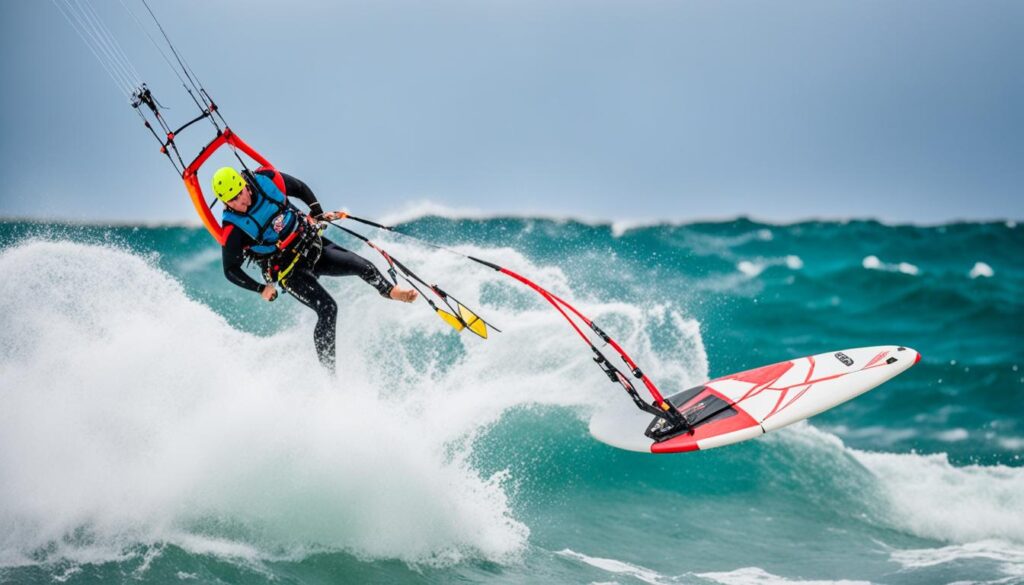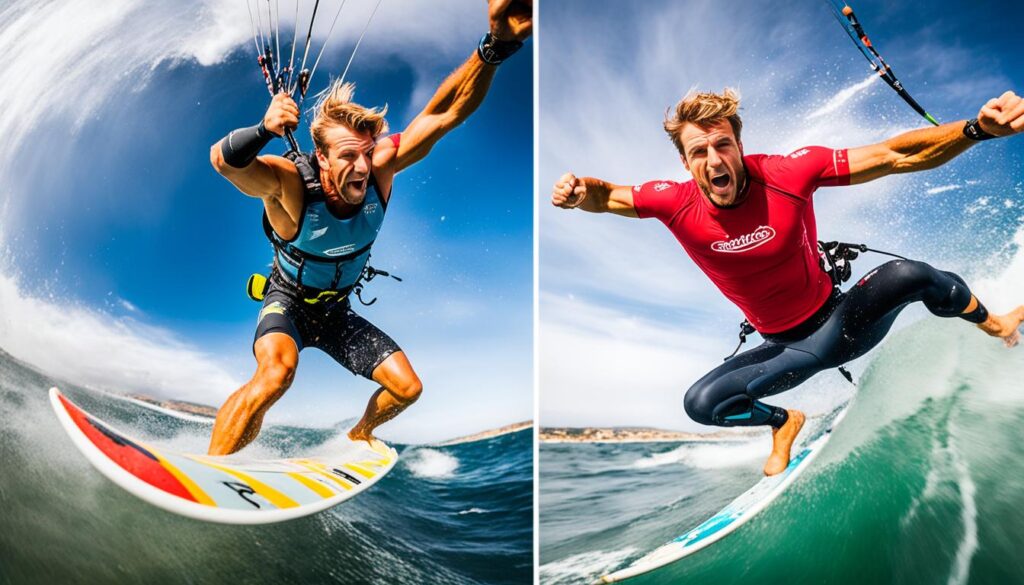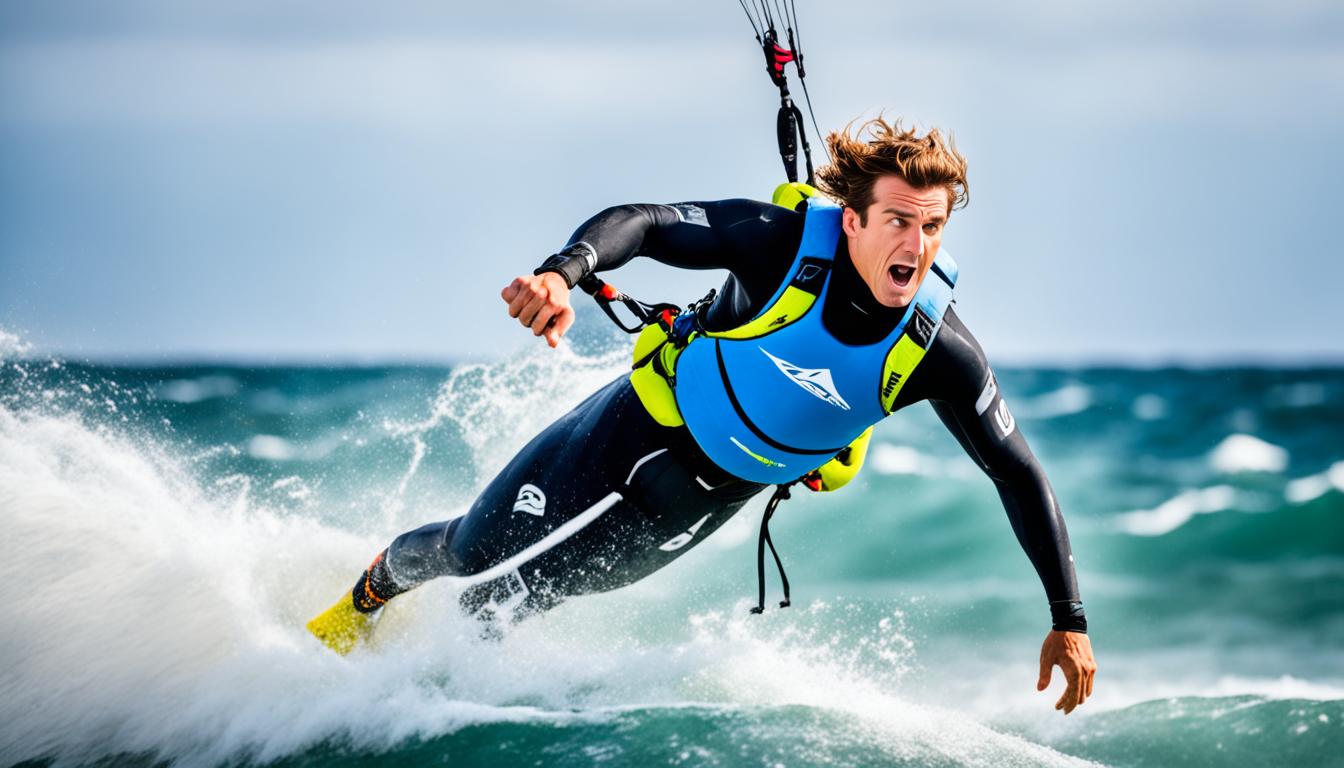Kitesurfing mixes surfing, sailing, and flying a kite. It calls to those who love adventure. If you’re thinking about trying it, you might wonder: Is kitesurfing hard? Many people want to know how tough it is, especially if they’re new to it.
This sport is both exciting and challenging. It tests your body and mind in a special way.
We’re here to clear up any confusion. We’ll talk about what you need to start and the challenges you’ll face. We’ll cover everything from basic skills to dealing with nature’s surprises. This will help you get ready for your kitesurfing journey, whether you’re just starting or dreaming about it.
Understanding the Basics of Kitesurfing
Starting with kitesurfing is exciting and a bit scary. It’s key to learn the basics first. You’ll need to know how to control the kite, body drag, and start on the water. These skills are the building blocks for all kitesurfing moves.
Learning to control the kite is very important. It means you can use the wind to keep you stable and powered. Beginners start with small kites to get better at handling them safely and well.
After kite control, it’s time to learn body dragging. This is when the kite pulls you through the water without standing up. It helps you move in the water and get ready to stand up on the board.
Water starts are the next big step. They let you use the kite’s power to get up from the water onto the board. It’s a fun moment for beginners. Getting good at this takes practice, but it makes starting your kitesurfing session exciting.
Are you ready to try kitesurfing? Remember, the key to getting better is to practice and be patient.
The Kitesurfing Learning Curve: What to Expect
Learning kitesurfing is exciting and tough. It’s like starting a new adventure with kites and boards. Knowing how to get better is key. Each step in learning brings new challenges.
At first, it’s hard to control the kite and stay balanced. But don’t give up. Beginners often face many challenges. These early steps are important for learning kitesurfing well.

As you get better, you’ll learn to turn and jump. The wind and your gear matter a lot here. Every new skill makes kitesurfing more fun and exciting.
The learning curve in kitesurfing can be tough. Be patient and keep practicing. Joining a community or getting help from experts is a big help. They offer support and tips to make learning easier.
Every kitesurfer’s path is different. Some move fast, others take more time. It’s important to go at your own speed and keep trying new things. This makes learning kitesurfing an exciting adventure.
Choosing the Right Gear: Costs and Considerations
When you start kitesurfing, picking the right gear is key for fun and safety. The cost of kitesurfing gear changes a lot. It depends on the brand, quality, and what you need.
For beginners, the best kite is one that’s easy to control. These kites help you learn without making mistakes. It’s important to spend money on good gear to stay safe and have fun.
Getting into kitesurfing can be expensive at first. You might spend a few hundred to several thousand dollars on the kite, board, harness, and more. Many people start by renting gear. This lets you try it out before buying and saves money.
Also, think about how much you can sell your kitesurfing gear for later. Good quality gear keeps its value well. This is good news for those watching their budget. You can sell your old gear and buy better stuff as you get better.
Knowing about all the kitesurfing gear and their prices helps you make better choices. It makes sure you have a great time, stay safe, and enjoy this exciting sport.
The Physical and Mental Demands of Kitesurfing

Kitesurfing is exciting, but it’s hard on the body and mind. Being fit for kitesurfing means more than just being in shape. It means having strong core muscles, being flexible, and able to last long on the water.
The mind also plays a big part in kitesurfing. Riders must stay focused and make quick decisions. This sport tests how strong you are in body and mind. It’s about beating fear and handling stress in fast-changing situations.
Whether you’re starting out or trying new tricks, you need both fitness and mental strength. A complete approach to kitesurfing helps you do better and stay safe. It lets you enjoy every ride with confidence.
Kitesurfing and the Elements: Battling Environmental Factors
Kitesurfing is an exciting sport. It’s important to know about kitesurfing weather conditions and kitesurfing wind. This helps with fun and kitesurfing safety. The weather and wind can change how well you do and how safe you are.
It’s key for kitesurfers to watch the weather closely. They need to know about wind directions and speeds. These things help you use the wind right for kitesurfing. Even pros must watch for sudden weather changes. These can turn a great day into a tough one.
The kitesurfing wind is important but can be tricky. You need enough wind to kite surf, but too much is risky. Beginners should start with mild winds and slowly get into stronger ones. They should know when to stop for safety.
Kitesurfing safety is more than wearing gear. It’s about making smart choices based on the weather. Always have a plan to get out safely. It’s good to kite with friends and pick spots that fit your skill level.
The weather can be unpredictable. Learning about kitesurfing weather conditions and kitesurfing wind is key. Following kitesurfing safety rules helps you enjoy the sport safely.
Progression in Kitesurfing: Celebrating Milestones and Overcoming Plateaus
Celebrating your wins and moving past tough spots is key in advanced kitesurfing. Every new trick you learn makes you feel proud and excited. It’s great to master your first jump or do cool kitesurfing tricks. These big moments are important to celebrate.
But, you might hit a wall where you don’t get better, called a plateau. To get past this, try changing up your practice. Trying different styles and conditions can make you better. Also, going back to basics can help you build a strong base for harder moves.
Setting small, achievable goals can help keep you going. Recording your rides or sharing your wins with others can also boost your motivation. Remember, learning kitesurfing is not a straight line. Every step you take, big or small, is a big deal.
Conclusion
Starting the kitesurfing journey is the start of an exciting adventure. It mixes thrill with skill. The learning process is as fun as riding the waves.
We looked at what gear you need and the costs. We also talked about the physical and mental strength needed for kitesurfing. Mastering kitesurfing takes time and builds your skills and mindset.
The kitesurfing adventure has ups and downs. It teaches you to work with nature and learn about the elements. You’ll hit many milestones, like your first successful launch or riding against the wind easily.
Every new skill you learn brings a sense of pride. Going from a beginner to a pro is a journey full of victories over challenges.
Kitesurfing is more than a sport; it’s a way to find yourself and grow. As we end, remember to stay positive with the wind and waves. Your kitesurfing journey is full of new experiences and lessons. May the winds be kind and your spirit stay high as you start this amazing adventure.
